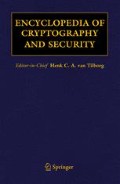References
Adams, C., P. Cain, D. Pinkas, and R. Zuccherato (2001). “Internet X.509 public key infrastructure time stamp protocols (TSP).” Internet Engineering Task Force, IETF RFC 3161, http://www.ietf.org/
Baric, N. and B. Pfitzmann (1997). Collision-free accumulators and fail-stop signature schemes without trees.” Advances in Cryptology—EUROCRYPT'97, Lecture Notes in Computer Science, vol. 1233, ed. W. Fumy. Springer-Verlag, Berlin, 480–494.
Bayer, D., S. Haber, and W.S. Stornetta (1993). “Improving the efficiency and reliability of digital time-stamping.” Sequences II: Methods in Communication, Security, and Computer Science, eds. R.M. Capocelli, A. De Santis, and U. Vaccaro. Springer-Verlag, Berlin, 329–334. (Proceedings of the Sequences Workshop, Positano, Italy, 1991.)
Benaloh, J. and M. de Mare (1991). “Efficient broadcast time-stamping.” Technical Report TR-MCS-91-1. Clarkson University Department of Mathematics and Computer Science.
Benaloh, J. and M. de Mare (1993). “One-way accumulators: A decentralized alternative to digital signatures.” Advances in Cryptology—EUROCRYPT'93, Lecture Notes in Computer Science, vol. 765, ed. Tor Helleseth. Springer-Verlag, Berlin, 274–285.
Boneh, D. and M. Franklin (2001). “Efficient generation of shared RSA keys.” Journal of the ACM, 48 (4), 702–722.
Buldas, A., P. Laud, H. Lipmaa, and J. Villemson (1998). “Time-stamping with binary linking schemes.” Advances in Cryptology—CRYPTO'98, Lecture Notes in Computer Science, vol. 1462, ed. Hugo Krawczyk. Springer-Verlag, Berlin, 486–501.
Haber, S. and W.S. Stornetta (1991). “How to time-stamp a digital document.” Journal of Cryptology, 3 (2), 99–111.
Haber, S. and W.S. Stornetta (1992). “Method for secure time-stamping of digital documents.” U.S. Patent 5,136,647, issued August 1992; Re. 34,954, reissued May 1995.
Haber, S. and W.S. Stornetta (1992). “Digital document time-stamping with catenate certificate.” U.S. Patent 5,136,646, August 1992.
International Organization for Standardization (2002–2003). Information technology—Security techniques—Time-stamping services. ISO/IEC 18014 (parts 1–3), http://www.iso.ch/
Massias, H., X. Serret Avila, and J.-J. Quisquater (1999). “Design of a secure timestamping service with minimal trust requirements.” Twentieth Symposium on Information Theory in the Benelux, eds. P. Vanroose, A. Barbé, E.C. van der Meulen. May 1999, 79–86.
Merkle, R. (1980). “Protocols for public key cryptosystems.” Proceedings of the 1980 Symposium on Security and Privacy. IEEE Computer Society Press, Los Alamitos, CA, 122–133.
Nyberg, K. (1996). “Commutativity in cryptography.” Proceedings of the First International Workshop on Functional Analysis at Trier University, ed. Walter de Gruyter. 331–342.
Sander, T. (1999). “Efficient accumulators without trapdoor.” Proceedings of the Second International Conference on Information and Communication Security, Lecture Notes in Computer Science, vol. 1726, eds. Vijay Varadharajan and Yi Mu. Springer-Verlag, Berlin, 252–262.
Surety. http://www.surety.com
Editor information
Editors and Affiliations
Rights and permissions
Copyright information
© 2005 International Federation for Information Processing
About this entry
Cite this entry
Haber, S., Massias, H. (2005). Time-stamping. In: van Tilborg, H.C.A. (eds) Encyclopedia of Cryptography and Security. Springer, Boston, MA . https://doi.org/10.1007/0-387-23483-7_431
Download citation
DOI: https://doi.org/10.1007/0-387-23483-7_431
Publisher Name: Springer, Boston, MA
Print ISBN: 978-0-387-23473-1
Online ISBN: 978-0-387-23483-0
eBook Packages: Computer ScienceReference Module Computer Science and Engineering

